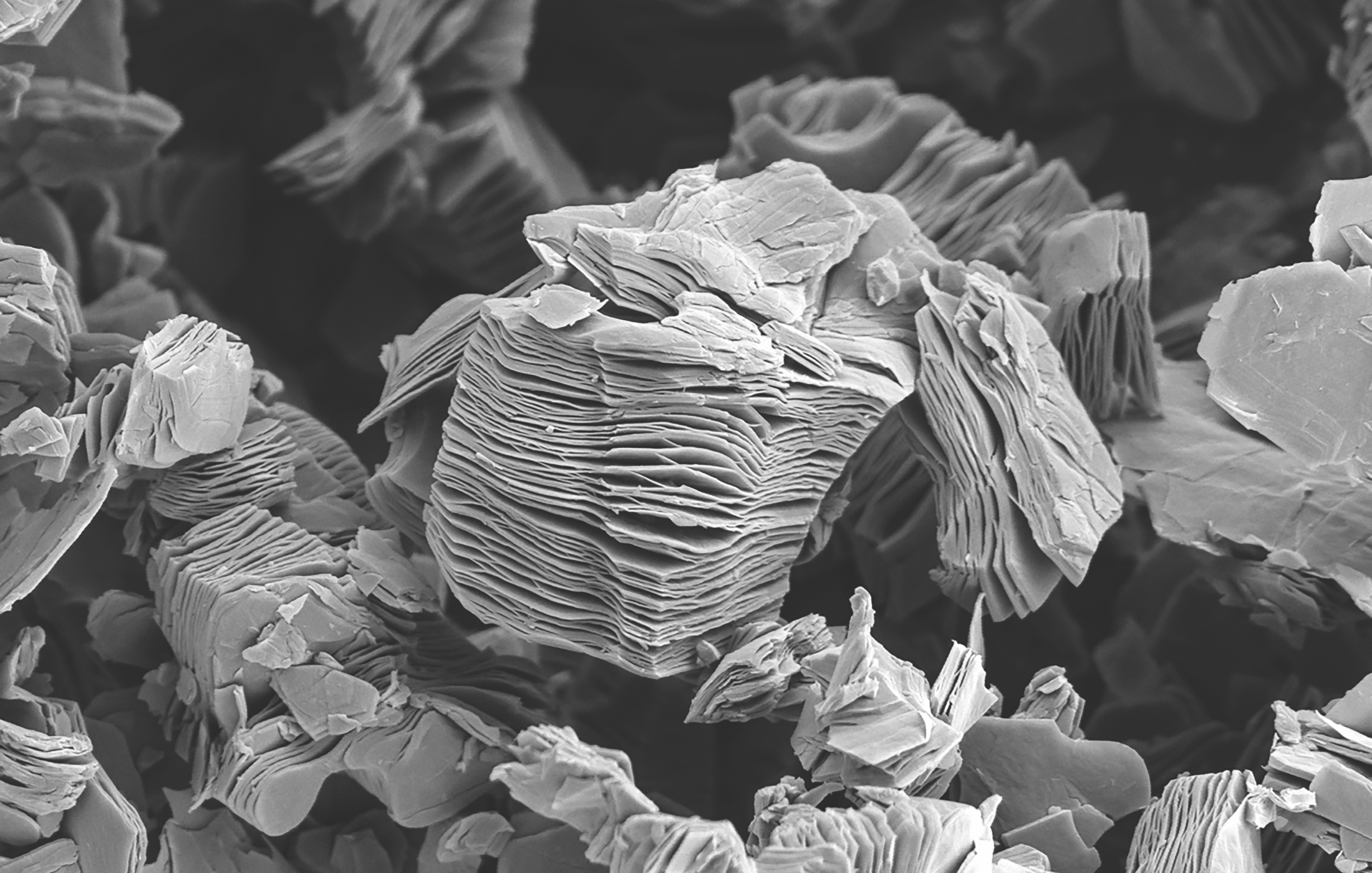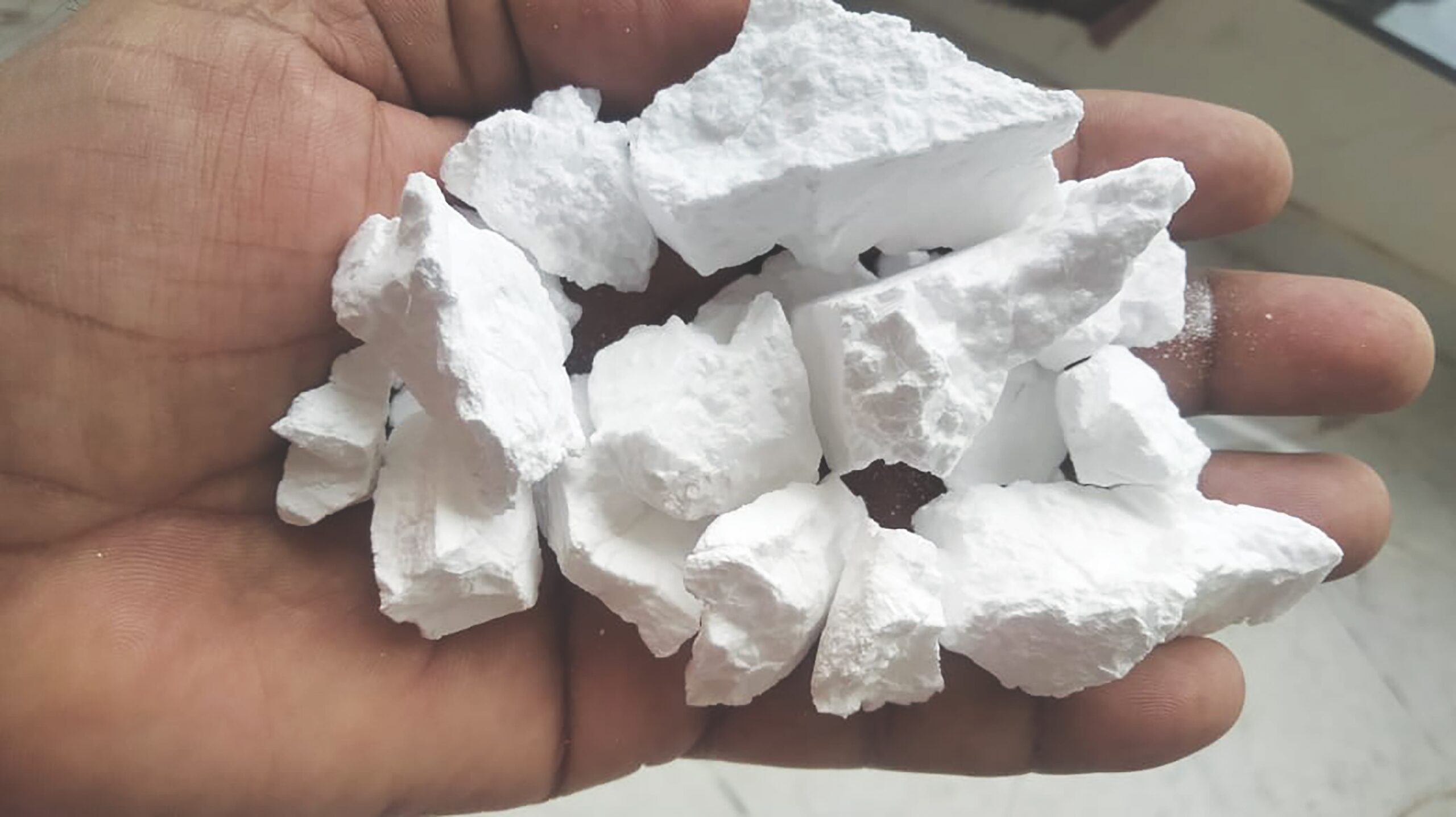For the last 100-some years, scientists have identified transition metal carbides, nitrides, and carbonitrides as ideal ceramic materials for applications requiring mechanically hard, electrically conductive, chemically stable, and ultrahigh-temperature properties.

Credit: Wyatt, Thakur, and Anasori
In the mid-1900s, advances in transition metal carbides and nitrides expanded to ternary phases of transition metal carbides and nitrides, known more commonly today as MAX phases. MAX phases, denoted by their chemical formula Mn+1AXn (n = 1 to 4), have a wide range of chemical diversity.1 M represents n+1 layers of transition metals from groups 3–6 of the 3d-5d block of the periodic table. X represents carbon and/or nitrogen, which occupy the octahedral interstitial sites of the M layers. The Mn+1Xn layers are interleaved with A-group elements, commonly from groups 13–16 of the periodic table.2
Research on MAX phases from the 1990s to early 2010s focused on high-temperature oxidation resistance, damage and corrosion tolerance, and self-healing capabilities.1 However, in 2011, investigation of the selective etching effect of hydrofluoric acid on the A-layers in MAX phases led to the discovery of a new field of layered 2D transition metal carbides and nitrides, known today as MXenes (Figure 1).3
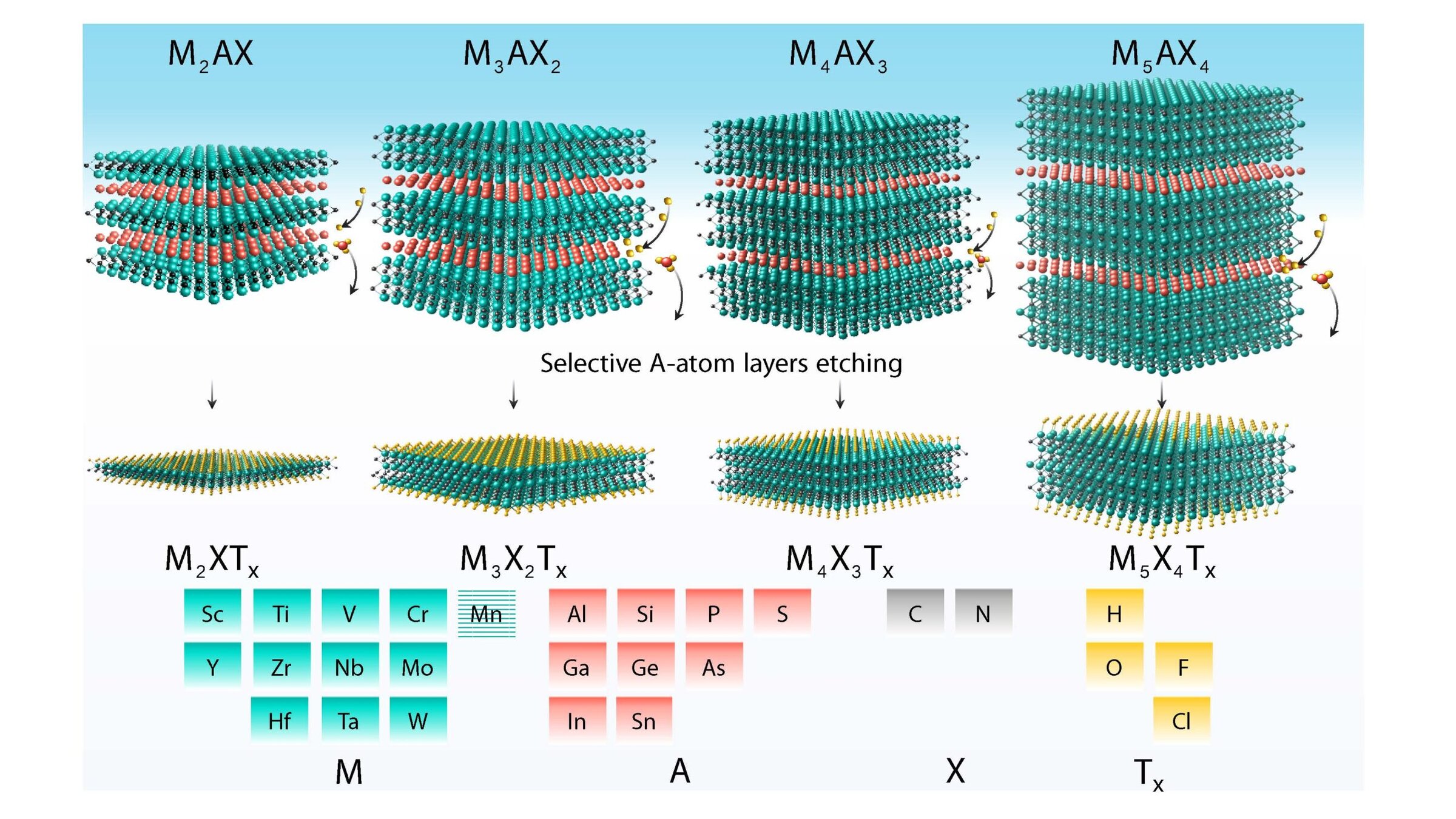
Figure 1. The large compositional and structural family of MXenes (Mn+1XnTx), which is derived from their MAX phase precursor (Mn+1AXn). Credit: Zhang et al., ACS Appl Mater Interfaces
Today, MXenes are an ever-expanding field of 2D transition metal carbides and nitrides that are commonly derived from their MAX phase precursors, such as Ti3C2Tx from Ti3AlC2, through selective etching of the A layers in MAX phases to yield their Mn+1XnTx layers. Because of the top-down synthesis process, MXenes derive their chemistry and structure from their respective MAX phase. The selective etching results in the formation of surface groups (shown as Tx) from their etching environment, which are commonly –O, –F, and –(OH).
As a derivative 2D material of MAX phases, MXenes also demonstrate a wide range of chemical and structural diversity, which leads to a range of impressive material behaviors, including electrical conductivity (up to 24,000 S/cm), mechanical stiffness (up to 386 ± 13 GPa), solution processibility (negative zeta potential of about –40 mV in aqueous solutions), electromagnetic interference shielding (up to 116 dB for total shielding effectiveness),4 catalytic activity,5 tribological behavior (6-fold reduction in coefficient of friction as a coating),6 and high-temperature stability in its hexagonal structure in inert environments (up to 800°C).7
As a result of these impressive properties, MXenes have seen an outpour of attention from the materials science community, with over 7,000 publications with the word MXene in their titles, as of June 2022 on Web of Science. The bulk of attention on MXenes from 2011 through 2015 focused on energy storage capabilities as a layered 2D nanomaterial, and the interest in energy storage is still expanding.8 However, increased attention in recent years focused on MXenes in other applications, including electrocatalysis, electromagnetic interference shielding, mechanical and tribological reinforcements, biomedical, and (very recently) as ultrahigh-temperature environment materials.
MXenes in electrocatalysis
Since the 1970s, scientists explored 3D grains of transition metal carbides and nitrides as alternatives for noble metals for electrocatalysis, such as hydrogen evolution reaction (HER), owing to their advantageous properties, namely high electrical conductivity, mechanical and chemical stability, and high melting point. In 1973, tungsten carbide was reported to have platinum-like catalytic behavior, which accelerated the development of tungsten carbide potential electrochemical properties.9 This discovery opened new avenues for researching and designing catalysts with platinum-like characteristics made of transition metal carbides and nitrides for electrocatalysis.
With their similar bonding behavior, 2D MXenes were also employed successfully in electrocatalysis due to their high electronic conductivity, hydrophilic nature, chemical stability, and high surface area, which is electrochemically active.5 In 2016, two reports, including a theoretical study on oxygen-terminated V2C MXene and an experimental study on Mo2CTx and Ti2CTx, pointed toward superior HER activity of MXenes.10,11 These findings demonstrated that Mo2CTx exhibits higher HER activity with lower overpotential than Ti2CTx toward HER. It was also shown that MXenes’ basal planes (2D sheet surfaces) are catalytically active toward HER.11
The large available basal surface area for catalytic activity paired with the chemical diversity of 2D MXenes lends promise to MXenes for use in future energy conversion applications, such as substituting platinum-based catalysts for efficient HER catalysis.
MXenes for EMI shielding
In the general transition metal carbides field, electromagnetic interference (EMI) shielding is sparsely reported compared to their mechanical stiffness, wear and corrosion resistance, and high-temperature behaviors. The lack of EMI shielding studies is despite the high electrical conductivity of bulk transition metal carbides and nitrides and possibly due to the difficulties of ultrathin film fabrication (such as foil fabrication) from these hard and high-melting point carbides and nitrides.
However, thanks to MXenes’ 2D structure, the EMI shielding of MXenes of different morphologies expanded to become a major application area, as MXenes can be fabricated as multilayer powder, aqueous solutions, or thin stacked films (Figure 2a).4,12 A 50-nm-thick film of Ti3C2Tx (about 24 sheets) showed an electromagnetic shielding capability of about 99% EMI shielding, which leads to an effective shielding of more than 3 million dB•cm2/g.12 While the electrical conductivity of MXenes is lower than copper and aluminum films, MXene EMI shielding effectiveness (EMI SE) is on par or even higher than those of copper and aluminum (Figure 2b).
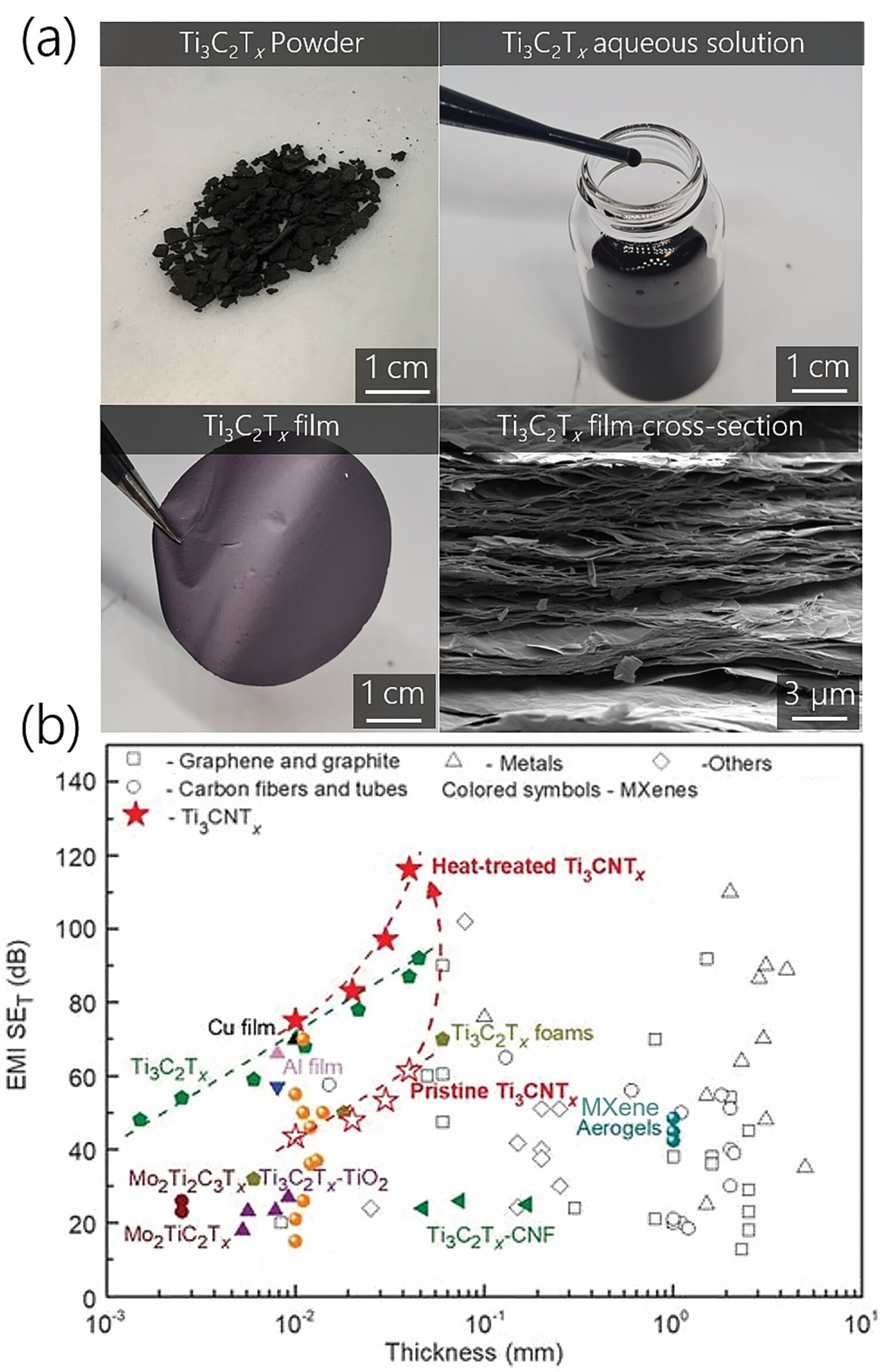
Figure 2. (a) Different MXene morphologies and (b) EMI shielding effectiveness of different MXene compositions as related to film thickness. Panel (b) reprinted with permission from Reference 14. Credit: (a) Wyatt, Thakur, and Anasori; (b) Iqbal et al., Science
Both reflection and absorbance mechanisms may contribute to the EMI shielding property of MXenes. Reflection is predicted to result from abundant free electrons on MXenes surfaces due to Tx and surface M layers, while absorbance is thought to come from energy transfer to the internal high electron density MXene lattice structure. The absorbance contribution of EMI shielding can be improved by using nitrogen with carbon as mixed elements in the X layers (Ti3CNTx MXene), as it is speculated that the added valence electron of nitrogen in Ti3CNTx results in increased absorbance of incident electromagnetic waves, leading to a larger EMI shielding effectiveness as compared to Ti3C2Tx (Figure 2b).12
The EMI SE behavior of Ti3CNTx compared to Ti3C2Tx illustrates the potential for compositional tuning of MXenes toward application-based design, as the top-down synthesis from their respective chemically diverse MAX phases permits a large range of potential compositions of MXenes available for synthesis. In addition to the chemical diversity, the solution processibility of MXenes allows simple processes to be used, such as vacuum filtration or paint-brush style spray-coating, to form flexible structures that can be used for EMI shielding and wireless communications.13,14 The combination of this compositional space and solution processibility results in a wide range of potential choices in chemistry and simplistic processing to form EMI shielding and EM antennas for use in next-generation electronics.
MXenes as mechanical and tribological materials
For those familiar with traditional carbide and nitride ceramics, stiff mechanical behavior and high wear resistance are key features of these ceramic materials. Bonding interactions in MXene between M and X structure dominate the mechanical behavior of MXene flakes. These M and X interactions in MXenes are mixed ionic/covalent/metallic bonded systems with different bond stiffnesses depending on the M and X chemistry and n number layering of Mn+1Xn. In short, bonded compositions such as molybdenum to carbon and tungsten to carbon have the stiffest bonds of carbide compositions while early transition metals, such as scandium to nitrogen or titanium to nitrogen, are the stiffest bonds of nitrides. This chemistry-dependent mechanical behavior of M–X implies MXene mechanical behavior is tunable by composition (Figure 3a).15
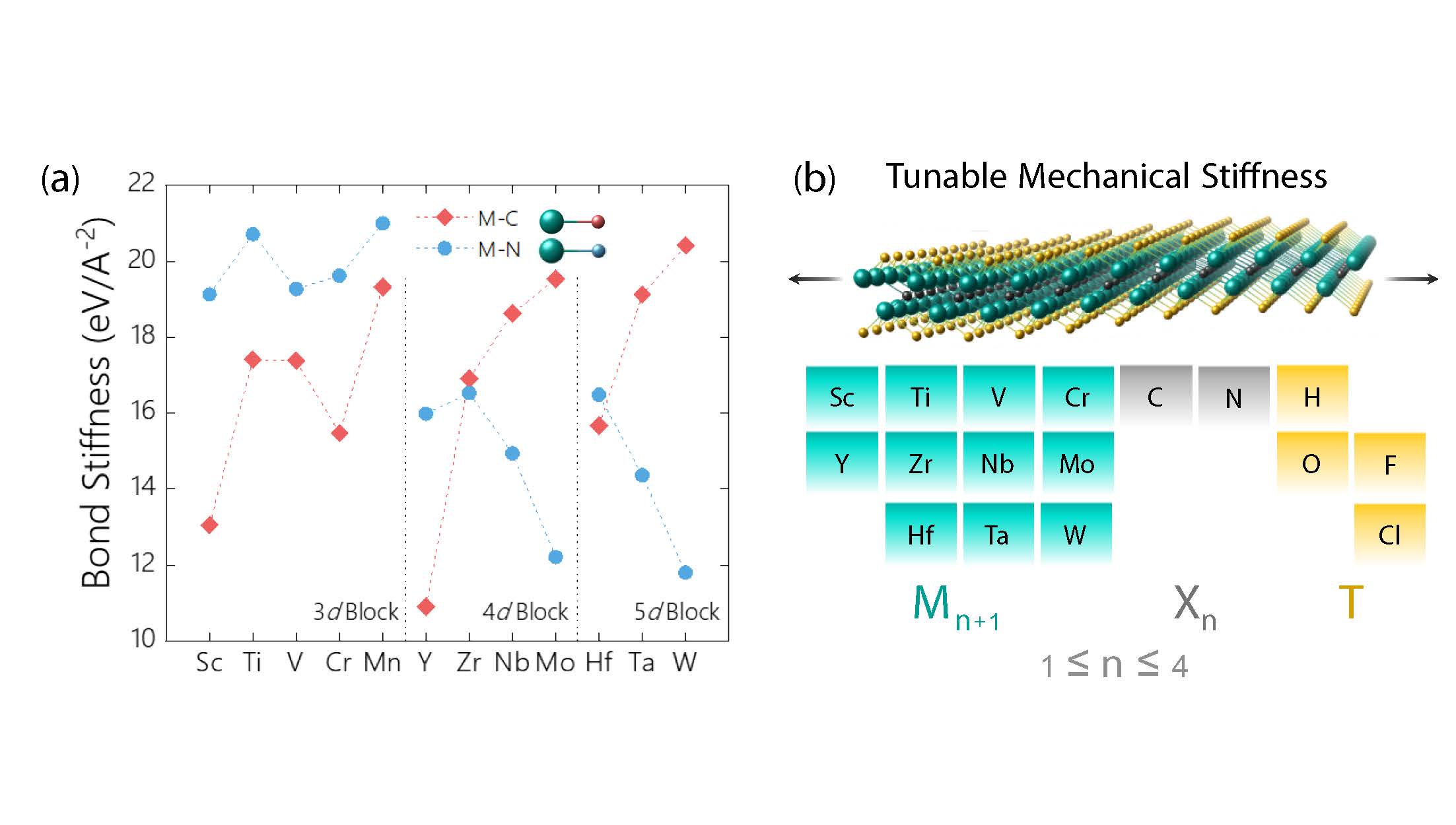
Figure 3. Tunability of the mechanical behavior of MXenes based on compositions, where various bond pairings shown in (a) can be chosen to affect the mechanical behavior of MXenes based on their possible chemistry and structure (b). Panel (a) reprinted with permission from Reference 16. Credit: (a) Wyatt et al., Advanced Materials; (b) Wyatt, Thakur, and Anasori
In addition, MXenes with a higher n have the highest in-plane stiffness due to the decreasing effect of the surface M layer on the mechanical behavior, for example, about 150 N/m for Ti2C as compared to about 350 N/m for Ti4C3.15 Similarly, Tx groups on the surface of MXenes influence their mechanical behavior even further, as O2-terminated MXenes are shown to have the highest in-plane mechanical stiffness of all other common surface groups due to the affinity of oxygen with transition metals. The mechanical behavior has exhibited the highest experimentally observed elastic moduli of all solution-processable nanomaterials to date for Ti3C2Tx and Nb4C3Tx at 330 ± 30 GPa and 386 ± 13 GPa, respectively.15
The capability of tuning the interior M–X chemistry of MXenes and the Tx surface groups based on MAX synthesis and selective etching (Figure 3b) yields a range of choices to experimentally determine the effects of composition, structure, and defects on the bonding behavior of transition metal carbides and nitrides at the nanoscale. Additionally, MXenes stiff in-plane mechanical properties are paired with very weak van der Waals interlayer interactions between MXene sheets, which makes them an incredibly stiff and tunable reinforcement materials. This information can be used to develop strong, stiff nanomaterials as additives for metal or ceramic matrices, and it can also inform design decisions of bulk transition metal carbide and nitride systems based on fundamental understanding.
Just as ceramic materials shown significant wear resistance under sliding force conditions, MXenes show promise as wear-resistant materials with an additional property of very low coefficient of friction (COF) in many uses ranging from lubricant additives, solid lubricants, and composite additives, outperforming even state-of-the-art nanomaterial choices (Figure 4).6,15 MXenes owe their impressive performance in tribological applications to their strong in-plane mechanical behavior paired with their comparatively weak out-of-plane van der Waals interlayer interactions. Their low COF can be attributed partly to the low energy barrier from Tx–Tx interactions toward interlayer sliding. Computational studies reported that Ti2CO2 has a sliding barrier of 0.017 eV while bare Ti2C (with no surface terminations) has a sliding barrier of 0.237 eV, which corresponds to COFs of 0.24–0.27 for bare titanium-based MXenes while O-terminated titanium-based MXenes have COFs of 0.10–0.14.16
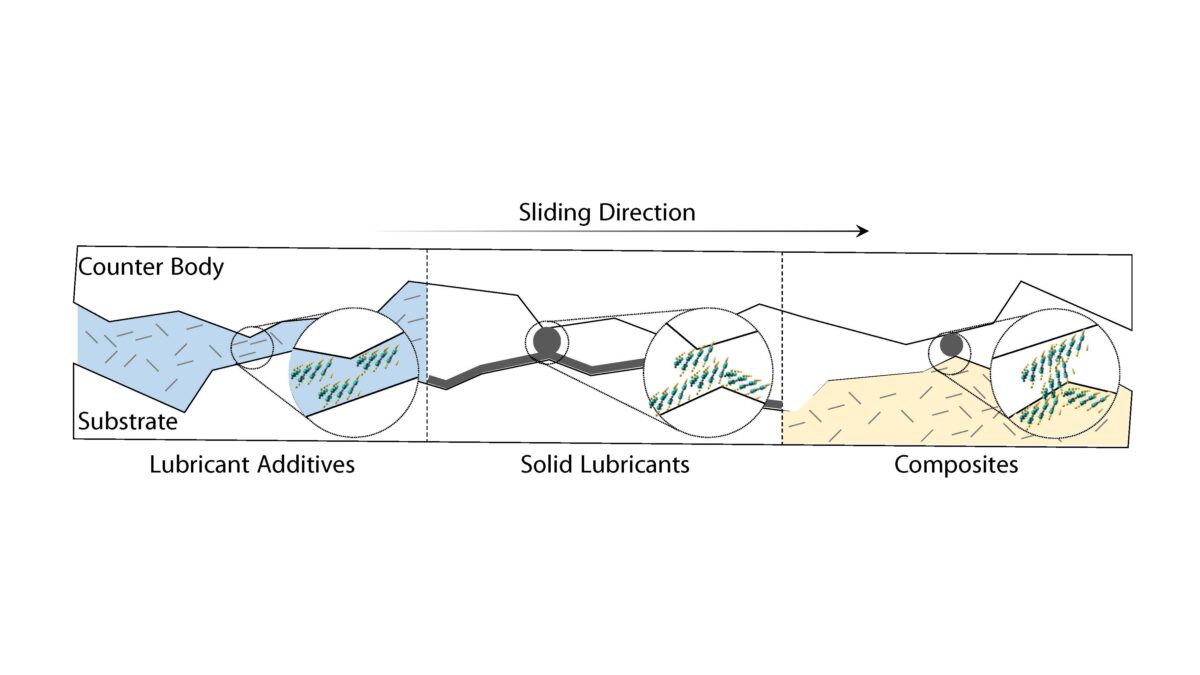
Figure 4. Example uses of MXenes in tribological applications including in lubricant additives, solid lubricant films, and composite additives. Reprinted with permission from Reference 16. Credit: Wyatt et al., Advanced Materials
The effect of M element and n values on the surface groups also showed an effect on the frictional behavior, as Ti3C2Tx and Nb2CTx terminated with O2 have surface dipole moment densities of 0.020 eV/Å and 0.011 eV/Å, respectively, which leads to lower adhesion forces and frictional forces for Nb2CTx compared to Ti3C2Tx.17 Their potential to improve mechanical wear resistance can be attributed to their strong in-plane mechanical bonding,15 which may improve average service life of MXene-coated bearings by 30% and 55% compared to similarly MoS2-coated and diamond-like carbon-coated bearings, respectively.18 These material behaviors illustrate that MXenes are ideal and tunable nanoceramics for use in high-wear and high-friction environments, which can lead to development of new low-friction equipment components or even triboelectric nanogenerators of energy.19
MXenes in extreme environments
Similar to their bulk transition metal carbide and nitride counterparts, MXenes’ interior transition metal carbide/nitride core lends the potential of their use in extreme conditions, such as ultrahigh-temperature environments. Although MXenes display detrimental oxidation behavior in water or oxygen-containing environments,20 carbide MXenes form ultrahigh-temperature nanolamellar carbides that are highly stable in inert high temperature environments (>1,500 °C).
This high-temperature phase transition of carbide MXenes to stable nanolamellar carbides in inert environments takes place in four main regimes (Figure 5), which occur in order of 1) loss of adsorbed species on the surface of each 2D sheet from room temperature to about 300 °C; 2) loss of surface Tx groups at temperatures up to 800 °C, followed by 3) beginning diffusion of atoms onto the surface to result in phase transformation of MXene from its hexagonal crystal structure to more stable nanolamellar carbides (titanium–carbide layers on top of Ti3C2, for example); and 4) complete phase transformation of MXenes to a stable nanolamellar carbide.7
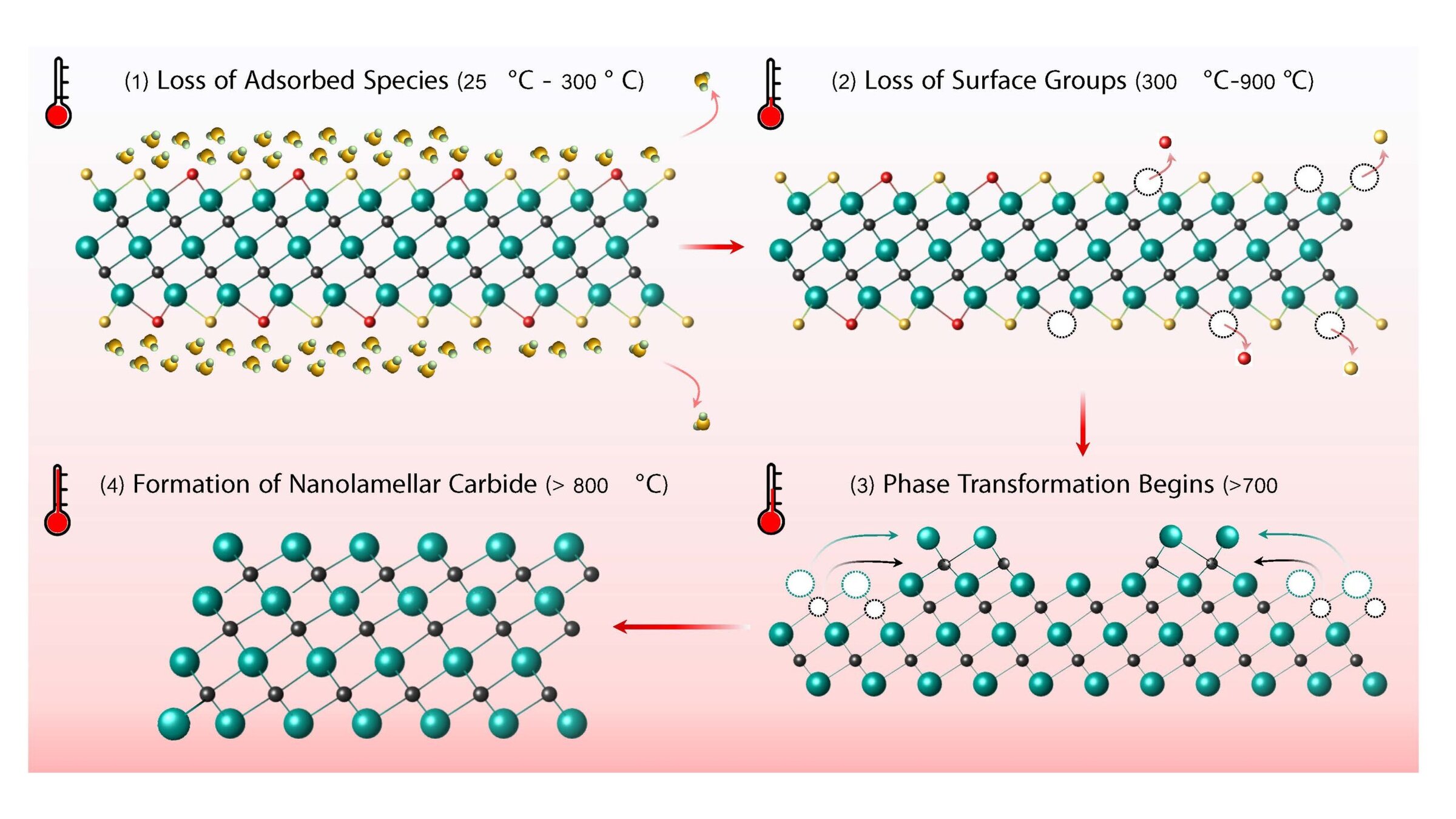
Figure 5. High-temperature phase behavior of MXenes, showing the four-stage behavior of MXenes in inert environments.Credit: Wyatt, Thakur, and Anasori
The extensive range of compositions of transition metals, carbon/nitrogen, and structural configurations of MXenes lends significant possibilities and engineering control of high-temperature phase behavior of MXenes. Additionally, MXenes’ solution processibility and their inherent negative zeta potential allow the addition of MXenes as additives and reinforcement materials in metal or ceramic composites (Figure 6a). The ease of film and coating fabrication make MXenes a unique precursor for ultrahigh-temperature coatings (Figure 6b).21 MXenes as precursors for extreme environment materials holds promise for MXene use in hypersonics, space exploration, nuclear reactors, and other extreme environment applications.
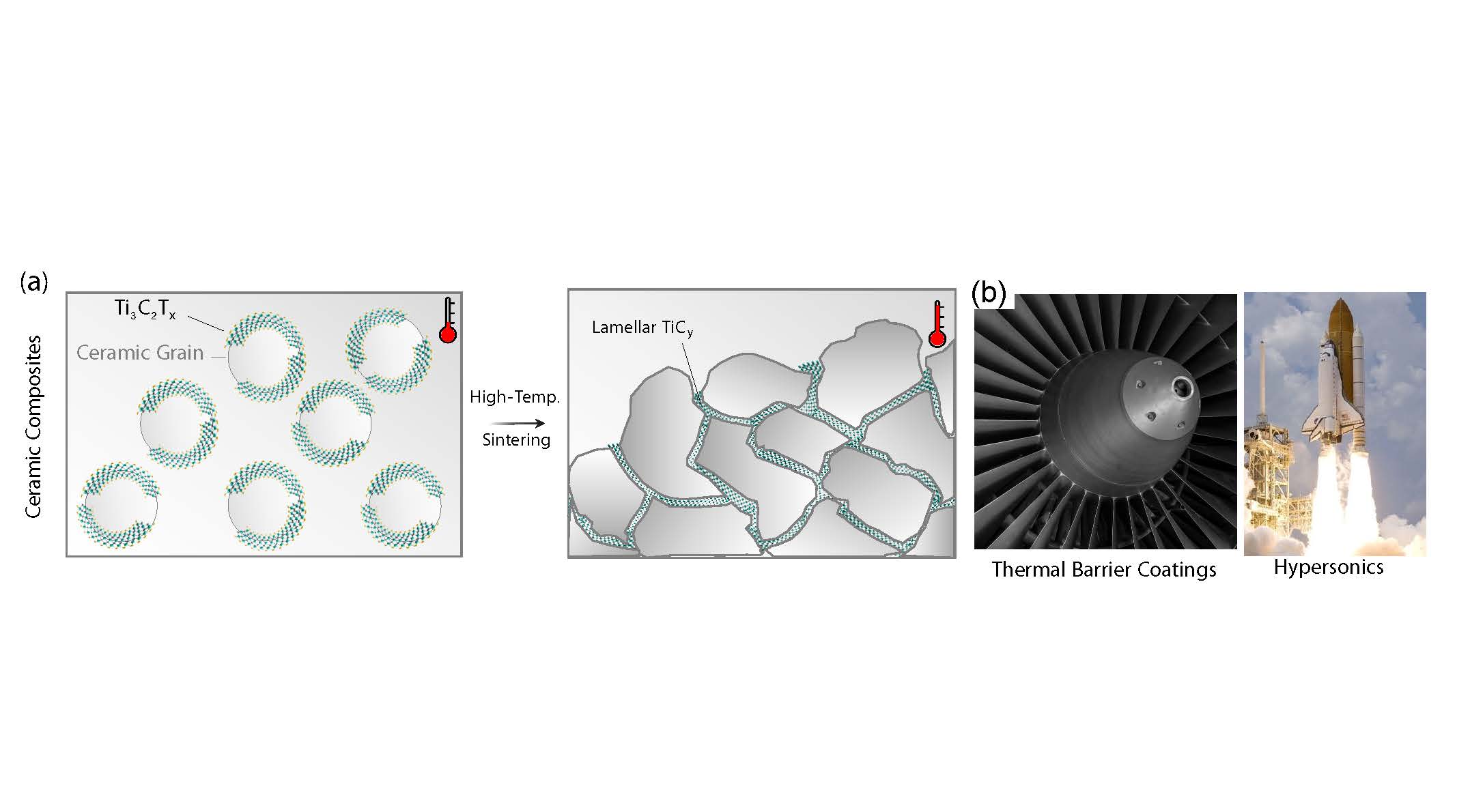
Figure 6. Future uses of MXenes as (a) additives in ultrahigh-temperature ceramics (UHTCs), can see MXenes used as strong binder materials in future extreme environment applications, such as (b) thermal barrier coatings on turbine blades and hypersonic travel. Adapted from Reference 21.Credit: Wyatt et al., Nano Convergence (CC BY 4.0)
Conclusion
The future for MXenes as an engineerable 2D nanoceramic material is bright because of their impressive electrochemical, electrical, EMI, mechanical, tribological, and ultrahigh-temperature behaviors. The wide range of chemical diversity, crystal structures, potential morphologies, and high surface area to volume ratio means that MXenes have the potential to be the premier building block of ceramics engineers in future demanding engineering challenges.
Future fundamental research exploring MXenes as nanoceramic building blocks will be needed to capitalize on MXenes’ as strong, ultrahigh-temperature reinforcements or thin-film materials that offer new materials solutions over traditional macroscale ceramics for use in future electronics, space exploration, or defense applications. With the addition of MXenes as a viable nanoceramic material, the future for the field of ceramic engineering is at the nanoscale.
Acknowledgement
The authors acknowledge the Office of Naval Research for supporting this research under award number N00014-21-1-2799.
Cite this article
B. C. Wyatt, A. Thakur, and B. Anasori, “MXenes for atomistic design of 2D nanoceramics,” Am. Ceram. Soc. Bull. 2022, 101(5): 24–28.
About the Author(s)
Brian C. Wyatt is a doctoral student and Anupma Thakur is a post-doctoral research associate at Indiana University–Purdue University (IUPUI) in the Mechanical & Energy Engineering Department, both under the advisement of assistant professor Babak Anasori. Contact Anasori at banasori@iupui.edu.
Issue
Category
- Engineering ceramics
- Manufacturing
Article References
1Barsoum, M. W. MAX phases: Properties of machinable ternary carbides and nitrides. (John Wiley & Sons, 2013).
2Sokol, M., Natu, V., Kota, S., and Barsoum, M. W., “On the chemical diversity of the MAX phases,” Trends in Chemistry 1, 210–223 (2019).
3Naguib, M. et al., “Two-dimensional nanocrystals produced by exfoliation of Ti3AlC2,” Adv. Mater. 23, 4248–4253 (2011).
4VahidMohammadi, A., Rosen, J., and Gogotsi, Y., “The world of two-dimensional carbides and nitrides (MXenes),” Science 372, eabf1581 (2021).
5Lim, K. R. G. et al., “Rational design of two-dimensional transition metal carbide/nitride (MXene) hybrids and nanocomposites for catalytic energy storage and conversion,” ACS Nano 14, 10834–10864 (2020).
6Grutzmacher, P. G. et al., “Superior wear-resistance of Ti3C2Tx multilayer coatings,” ACS Nano 15, 8216–8224 (2021).
7Wyatt, B. C., Nemani, S.K., Desai, K., Kaur, H., Zhang, B., and Anasori, B., “High-temperature stability and phase transformations of titanium carbide (Ti3C2Tx) MXene,” Journal of Physics: Condensed Matter 33 (2021).
8Anasori, B., Lukatskaya, M. R., and Gogotsi, Y., “2D metal carbides and nitrides (MXenes) for energy storage,” Nat. Rev. Mater. 2, 16098 (2017).
9Levy, R. and Boudart, M., “Platinum-like behavior of tungsten carbide in surface catalysis,” Science 181, 547–549 (1973).
10Ling, C., Shi, L., Ouyang, Y., Chen, Q., and Wang, J., “Transition metal–promoted V2CO2 (MXenes): a new and highly active catalyst for hydrogen evolution reaction,” Advanced Science 3, 1600180 (2016).
11Seh, Z. W. et al., “Two-dimensional molybdenum carbide (MXene) as an efficient electrocatalyst for hydrogen evolution,” ACS Energy Letters 1, 589–594 (2016).
12Iqbal, A., Kwon, J., Kim, M. K., and Koo, C. M. “MXenes for electromagnetic interference shielding: Experimental and theoretical perspectives,” Materials Today Advances 9, 100124 (2021).
13Asia Sarycheva, A. P., Liu, Y., Dandekar, K., Anasori, B., and Gogotsi, Y., “2D titanium carbide (MXene) for wireless communication,” Sci Adv 4, 1–8 (2018).
14Iqbal, A. et al., “Anomalous absorption of electromagnetic waves by 2D transition metal carbonitride Ti3CNTx (MXene),” Science 369(6502), 446–450 (2020).
15Wyatt, B. C., Rosenkranz, A., and Anasori, B., “2D MXenes: Tunable mechanical and tribological properties,” Advanced Materials 33, 2007973 (2021).
16Zhang, D. et al., “Computational study of low interlayer friction in Tin+1Cn (n = 1, 2, and 3) MXene,” ACS Appl Mater Interfaces 9, 34467–34479 (2017).
17Zhou, X., Guo, Y., Wang, D., and Xu, Q., “Nano friction and adhesion properties on Ti3C2 and Nb2C MXene studied by AFM,” Tribology International 153, 106646 (2020).
18Marian, M. et al., “Ti3C2Tx solid lubricant coatings in rolling bearings with remarkable performance beyond state-of-the-art materials,” Applied Materials Today 25 (2021).
19Jiang, Q. et al., “MXene electrochemical microsupercapacitor integrated with triboelectric nanogenerator as a wearable self-charging power unit,” Nano Energy 45, 266–272 (2018).
20Huang, S. and Mochalin, V. N., “Hydrolysis of 2D transition-metal carbides (MXenes) in colloidal solutions,” Inorg. Chem. 58, 1958–1966 (2019).
21Wyatt, B. C., Nemani, S. K., and Anasori, B., “2D transition metal carbides (MXenes) in metal and ceramic matrix composites,” Nano Convergence 8, 16 (2021).
Related Articles
Bulletin Features
Sintered synthetic cristobalite: Innovative kiln-based thermal transformation of quartz
Cristobalite, a high-temperature polymorph of silica, is widely used in ceramics, glass, paints, refractories, and dental materials due to its low density, high whiteness, thermal expansion behavior, and mechanical stability. Traditional cristobalite production methods rely on static sintering of finely ground quartz at high temperatures (~1,750°C) for extended durations (2–3…
Market Insights
Bioactive glass continues to transform medical care decades after first hitting the market
Almost 60 years ago, a chance meeting led to pioneering work that has improved medical care and seeded future innovations. In the late 1960s, a young professor named Larry Hench traveled to a conference in Sagamore, N.Y., where he happened to sit next to a U.S. Army colonel who was…
Market Insights
Sustainable development and design: Inspiration from landscape-shaping creatures
Animals are not just passive inhabitants of their environment. Many are architects of the natural world, actively shaping landforms and water bodies as they move around, feed, build homes, and reproduce. This impact by animals on different biomes has traditionally been overlooked in the environmental sciences. But scientists and engineers…
